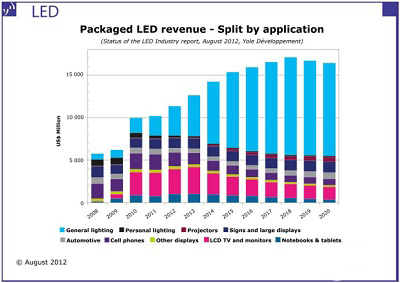According to a new report, "Status of the LED Industry," a cost reduction per lumen of packaged LEDs by a factor ten is necessary for mass LED adoption to occur in lighting.
Growth of the LED industry has come initially from the small display application and has been driven forward by the LCD display application. LED TV was expected to be the LED industry driver for 2011 but the reality was quite different.
This is according to the new report, "Status of the LED Industry," released by Yole Développement and EPIC. Lower adoption of LEDs in the TV market and the entry of several new players, mostly from Asia, created a climate of overcapacity, pricing pressure and strong competition. As a result, packaged LED volume was about 30% lower than expected and revenue shrank due to strong ASP pressure. According to experts from R&D institute imec, the current price of LED LCD TVs is overinflated and not justified over that of ordinary LCD TV's despite their superior quality.
"In 2012, most companies have moved to the new "El Dorado" of LED business: general lighting, which represents the next killer application for LEDs. But enabling massive adoption of the technology for such an application still requires a large decrease in the cost of LED-based products…," explains Pars Mukish, Market and Technology Analyst, LED at Yole Développement.

The report estimates that packaged LED revenue will reach a market size of $11.4 billion in 2012 and will peak to $17.1 billion by 2018. Growth will be driven both by the display (LCD TV) and general lighting applications until massive adoption of LEDs in lighting.
From 2014, the third growth cycle of the LED business will accelerate with the general lighting application representing more than 50% of the overall packaged LED business. In terms of volume, LED die surface will increase from 22.5 billion mm² (2012) to 80 billion mm² (2018). This will prompt substrate volume growth from 8 million x 2" equivalent (TIE) in 2011 to 39.5 million x 2" equivalent in 2018 with a CAGR of 26%.
The cost of packaged LEDs still needs to be reduced by a factor ten in order to enable massive adoption in general lighting.
The adoption of LEDs for general lighting applications strongly depends on technology and manufacturing improvements. This is required to drive performance and cost of LED solutions to a trigger point where massive adoption could start. Industry consensus points out a cost reduction per lumen of packaged LEDs by a factor ten.
This can be achieved through a combination of manufacturing efficiency and performance improvement. These include access to larger size wafers and improvements in LED epitaxy which would drive down cost of ownership through yield and throughput. Also, improved package and luminaire design will also enable significant cost reductions.
China's GaN MOCVD reactor capacity has increased by a factor twenty in the last 3 years
The capacity for GaN LED epitaxy increased dramatically in 2010 and 2011. This increase took place across all regions but was most dramatic in China, where an increase by a factor twenty of reactor capacity took place between Q4 2009 and Q1 2012.
"Most emerging Chinese LED epiwafer and die manufacturers are still lagging significantly behind their competitors in term of technology maturity and LED performance," says Eric Virey, Senior Analyst, LED at Yole Développement.
The bulk of those new companies are not yet capable of manufacturing LEDs to address the large display and general lighting applications that are currently driving the market. In the mid-term, consolidation of the Chinese LED industry will occur (scenario in the central government's new five-year plan), and China should became a major player in the LED industry.
Another factor is that new business models are mandatory to capture the added value of LED lighting.
Ultimately, the long life of Solid State Lighting (SSL) technology will totally change the lighting market by dramatically increasing the length of the replacement cycles. The replacement market will be strongly impacted, pushing traditional players of the lighting industry to define new strategies to capture profit. These include technologies include intelligent lighting and different lighting solutions.
"In addition, as value is moving to the top of the value chain (module and luminaire levels), several players that were originally involved only at LED device levels will develop strategies of vertical integration in order to capture more value," adds Tom Pearsall, General Secretary, EPIC.
But accessing distribution channels represents a big challenge for those players who develop new approaches to sell their lighting products such as e-commerce and new distributors. The rise of LED lighting will therefore depend on the right merger of the emerging LED industry with the traditional lighting industry.




